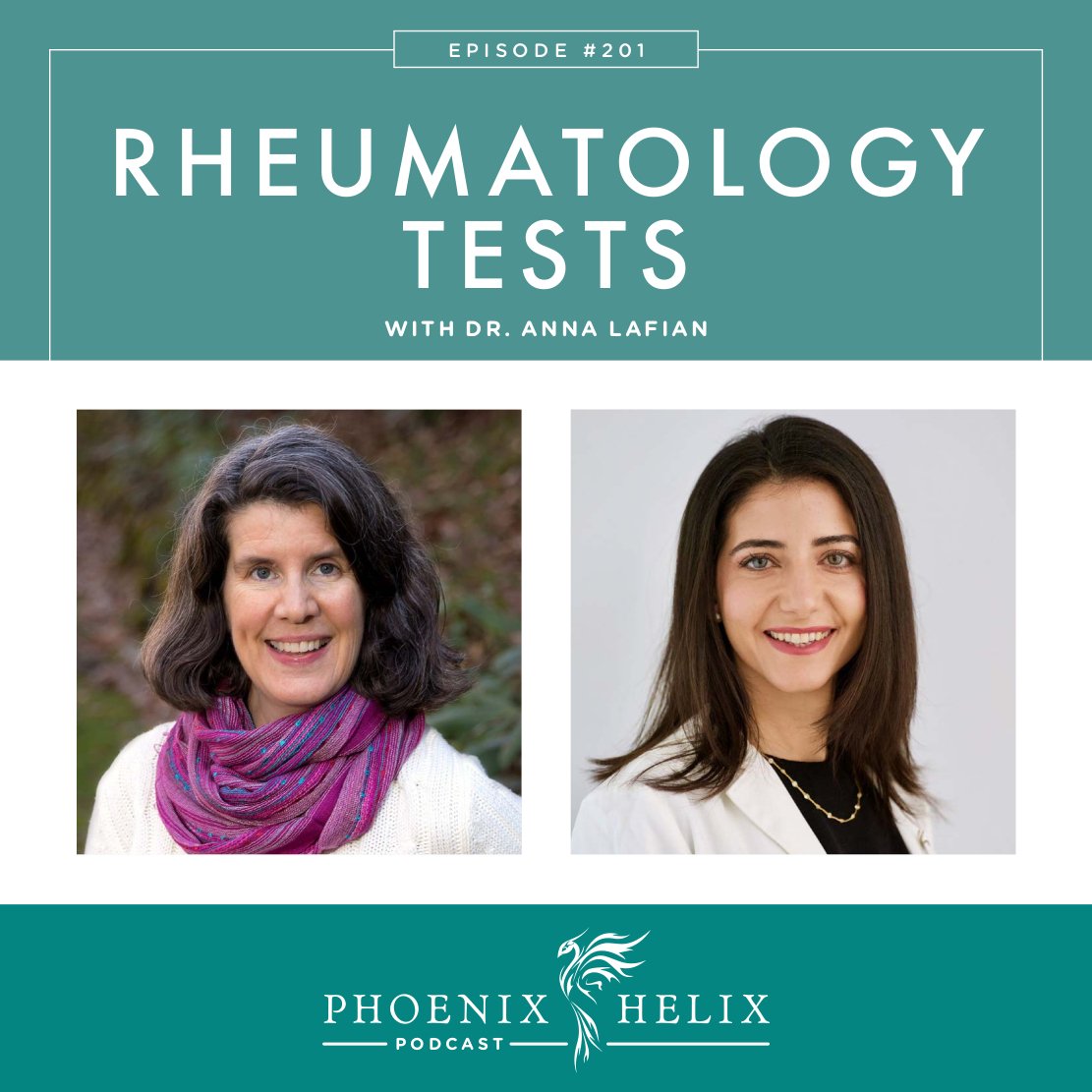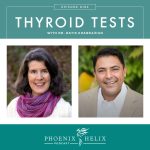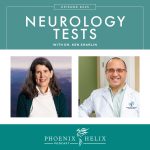Understanding Autoimmune Lab Results
If you get referred to a rheumatologist and they suspect autoimmune disease, there’s a list of tests they run as part of the diagnosis process. If you’re diagnosed with autoimmune disease, there are specific tests that help monitor disease activity and also your response to prescribed medications. What are these tests, and what does each one measure? How important are they in the diagnosis and monitoring process? These are the questions we’ll be answering today. I believe in being an empowered patient, and part of that is clearly understanding the medical care we receive. Our goal today is to help you understand your lab work better. And if you’re undiagnosed and have never received these tests, you can request them from your doctor. My guest is Dr. Anna Lafian, an integrative rheumatologist who believes in a holistic approach to patient care. She is board certified in both internal medicine and rheumatology. She also has a master’s degree in complementary and alternative medicine.
Listen to the Show
- Subscribe to my podcast through your favorite podcast app: iTunes, Stitcher, Google, TuneIn, Spotify, Amazon, etc.
- You can also listen to the episode right here through the player below, and if you subscribe to my newsletter you’ll get notified of future episodes.
Podcast: Play in new window | Download
Show Notes
- Intro (0:00)
- Thank You to Our Podcast Sponsor – Autoimmune Strong (2:52)
- Have you heard of Autoimmune Strong yet? It’s the ONLY exercise program designed FOR people living with chronic pain, BY someone living with chronic pain.
- Andrea Wool, the personal trainer behind Autoimmune Strong, is an autoimmune warrior herself. She struggled for years trying to figure out how to exercise in a way that made her feel good, but all the fitness programs she tried ended up causing flare-ups and exhaustion instead. She knew there had to be a better way. So she studied, experimented, and created a program that works FOR people with autoimmune disease.
- The goal of Autoimmune Strong is to help you gain strength, flexibility, and mobility, without causing exercise induced flare-ups or post-exercise exhaustion.
- All the exercises can be done at home – no gym necessary. And there is a ton of support built in all along the way, with access to expert coaches, monthly zoom calls with Andrea, and an amazing membership community filled with other people just like you.
- You can try Autoimmune Strong for free! Everyone gets a 7-day free trial. Andrea is also giving my listeners an extra discount of 10% off your first month with the code PHOENIX.
- We all deserve to feel healthy and strong in our bodies. You deserve a life with fewer flares and more joy. Learn more at GetAutoimmuneStrong.com.
- Meet Dr. Anna Lafian (4:45)
- Dr. Anna Lafian is an integrative rheumatologist who believes in a holistic approach to patient care. She’s board certified in both internal medicine and rheumatology. She also has a master’s degree in complementary and alternative medicine. And she empowers her patients as partners in their healthcare, believing in the power of diet, lifestyle, and mindset interventions for health.
- She was drawn to rheumatology because it requires an all-encompassing understanding of the body. Autoimmune diseases can impact multiple organ systems, and many health conditions can also mimic autoimmune disease. She fell in love with the investigative nature of the work. Her first appointment with new patients is usually an hour, and she tries to put together a timeline of their health. Often, first symptoms appear years before diagnosis.
- She was always interested in a holistic and integrative approach to medicine, because she was raised by a father who approached healthcare that way for their family. He encouraged her to do the same once she became a doctor. She believes everything is connected – not just all the systems of the body, but mind-body-spirit as well.
- What Conditions Do Rheumatologists Treat? (12:21)
- Inflammatory forms of arthritis: which are often autoimmune and include rheumatoid arthritis, psoriatic arthritis, ankylosing spondylitis, polymyalgia rheumatica, and others.
- Connective tissue disease: which include lupus, MCTD, scleroderma, Sjogren’s, and others.
- Soft tissue rheumatisms: non-autoimmune conditions isolated to one area of the body which include tendonitis, fasciitis, bursitis, carpal tunnel syndrome, etc.
- Chronic widespread pain conditions: fibromyalgia, osteoarthritis, etc.
- Metabolic conditions: like osteoporosis, gout, Stills disease, and familial Mediterranean fever.
- There is overlap in these categories, but it shows the breadth of the field of rheumatology.
- Erythrocyte Sedimentation Rate (ESR) (14:37)
- ESR is a general marker of bodywide inflammation.
- It’s a blood test that measures the distance in milliliters that red blood cells fall within a test tube over one hour. The faster they fall, the higher the level of inflammation in the body.
- With blood tests, different labs use slightly different ranges to quantify normal vs. abnormal results, and both gender and age are factors. Women naturally have higher ESR levels than men, and as people age, ESR levels tend to go up for everyone.
- Generally speaking, men under age 50 should have an ESR of less than 15. Above age 50, men should have an ESR below 20. Women under age 50 should have an ESR of less than 20, and above age 50 should have an ESR below 30.
- ESR levels above 100 might indicate infection, cancer, or very active autoimmune activity. But any result markedly above normal is a red flag to research further.
- There are also non-inflammatory causes of an elevated ESR, including obesity, anemia, and pregnancy.
- C-Reactive Protein (CRP) (20:11)
- CRP is one of a group of proteins called acute phase reactants that go up in response to inflammation. Human beings have trace amounts of CRP in their plasma naturally, but when there’s inflammation in the body, the liver produces more CRP in response to that inflammation.
- Different labs use different scales of measurement. CRP should be less than 0.5-1 mg/dl (or less than 5-10 mg/l).
- Usually, CRP is associated with acute inflammation, and ESR is associated with chronic inflammation. CRP levels react quickly, rising within a few hours of the onset of inflammation, and they lower just as quickly as inflammation in the body recedes. ESR levels usually take a day or two to shift. However, with active autoimmune disease where the patient isn’t in remission, both of these levels may be high.
- hs-CRP is a version of this test that checks trace levels of inflammation. In conventional medicine, it’s most commonly used by cardiologists to assess cardiac risk. In functional medicine, it’s considered a more sensitive inflammation marker. In rheumatology, it’s rarely used. Note: This test isn’t superior to a regular CRP test. It has a different purpose. If your regular CRP is high, your hs-CRP will automatically be high. But if your regular CRP is normal, hs-CRP looks at trace levels that aren’t measured on the regular CRP test.
- Thank You to Our Podcast Sponsor – ShopAIP (25:47)
- Today, I’m highlighting their AIP-friendly chips. Sometimes, you just want something to crunch, and most traditional grocery store chips are off the table during the elimination phase of the AIP. ShopAIP has your craving covered! They sell a wide variety of AIP options, including plantain chips, sweet potato chips, beet chips, cassava strips, apple chips, coconut chips, seaweed snacks, paleo puffs, and pork rinds. If you have any travel plans this summer, they’re wonderful to have in the car.
- Nutrient-dense note: I believe treats like these make a healing diet sustainable and keep us from feeling deprived. That’s important! But it’s also important to remember they’re treats. For optimal healing, make the center of your diet whole foods that don’t come in a bag.
- ShopAIP is an online store dedicated to the Paleo Autoimmune Protocol. With hundreds of items for the elimination phase of the AIP, and products labeled by reintroduction category as well. You can find protein bars, sauces and condiments, AIP-friendly spices, cooking and baking ingredients, waffle and pancake mix, delicious snacks, and more.
- If you’re a first-time customer, use the code PHOENIX for 10% off your order. Purchase here.
- What Are Antibodies?
- Note: there’s no time stamp for this section because this conversation was entwined with the ANA conversation. I separated it here for clarity, because it applies to all antibody tests.
- One of the ways our immune system protects us is by producing antibodies against external pathogens. They act as a bullseye, drawing other immune cells to remove that pathogen from the body.
- However, sometimes these immune cells mistake our own cells for pathogens and create autoantibodies – antibodies against the self. That happens with every autoimmune disease, and different antibodies are involved with different diagnoses.
- The presence of autoantibodies doesn’t always mean an autoimmune attack is happening. Healthy people sometimes have them, even when they don’t have autoimmune disease. Lab tests will have a range indicating what number is high enough to indicate a potential autoimmune diagnosis. However, diagnoses are never made on the basis of one lab test. There are many factors rheumatologists consider when making a diagnosis: health history, symptoms, and a wide variety of tests (not just one).
- Sometimes it’s a relief not to have an autoimmune diagnosis, but other times it can be frustrating if you have symptoms and don’t know what’s wrong. One theory is that there’s a spectrum of autoimmunity, and if you intervene early with diet-lifestyle-mindset, you may be able to prevent autoimmune disease from developing.
- Resource Podcasts:
- Antinuclear Antibodies (ANA) and Follow-Up Tests (27:27)
- ANA is an antibody created against the nucleus of our cells, and it’s commonly present in autoimmune diseases that affect the connective tissue.
- ANA levels can be tracked through a blood test. In the lab, special test cells are placed on a microscope slide, and the patient’s blood is added to the slide. The test cells have hundreds of antigens. If the patient’s blood contains ANA antibodies, they will bind to the antigens like puzzle pieces. A fluorescent stain is then placed on the slide which lights up the antibodies. making them glow. For this reason, the test is called an Immunofluorescence Assay (IFA). In addition to antibody levels, this test also shows patterns, and certain patterns are associated with certain autoimmune diseases.
- Since healthy people sometimes have low levels of ANA antibodies, the level where rheumatologists start to worry is 1:160 and higher. If the ANA level is high, a second panel of tests is often run to get more information. These are called Extractable Nuclear Antigen Antibodies (ENA). Each one of these antibodies are associated with specific autoimmune diagnoses.
- Other follow-up tests based on ANA results may include antiphospholipid antibodies and complement proteins, and each provides a puzzle piece toward diagnosis.
- Once diagnosis is made, conventional rheumatologists don’t usually repeat these tests. They’re seen as diagnostic tools only. The one exception is the double-stranded DNA antibody, which correlates to lupus activity. Other antibodies don’t usually rise and fall in the same way. However, Dr. Lafian will sometimes run repeat antibody panels for patients who are making diet and lifestyle changes that lead to improvement in their symptoms. She has seen antibody levels go down in those situations, and that can be very motivating for the patient. However, it’s also possible for antibodies to remain as symptoms improve. Don’t be discouraged if that’s true for you. There are other lab tests that will show the reduced inflammation and disease activity, and it’s possible to have antibodies even when in remission.
- Rheumatoid Factor & Anti-CCP (42:42)
- These are the antibody tests run when a rheumatologist suspects rheumatoid arthritis or inflammatory arthritis.
- Rheumatoid factor (RF) is an antibody against a particular fragment of immunoglobulin (IgG). IgG is a normal antibody we all have that helps fight off infections and pathogens. So RF is actually an antibody against an antibody. When RF binds to IgG, it forms an immune complex that can cause inflammation and disease.
- Anti-CCP is an antibody against cyclic citrullinated peptide. CCP is usually created during an inflammatory process.
- Both of these antibodies are associated with rheumatoid arthritis. However, it’s not a perfect correlation. Most patients with RA have RF (but not all), and it’s possible to test positive for RF and not have RA. RF is usually caused by disease activity, but occasionally, other diseases are the cause. Anti-CCP is more closely associated with RA, but not every RA patient has this antibody. So, again these are puzzle pieces which are combined with other lab tests, patient’s health history, and clinical symptoms to make a diagnosis. When a patient has neither antibody, they’re more likely to be diagnosed with another form of inflammatory arthritis.
- Monitoring Labs (48:15)
- After being diagnosed with autoimmune disease, certain lab tests are run to monitor your health going forward. They track inflammation, disease activity, potential complications, and your response to treatments – positive or negative.
- Some tests are run on all autoimmune disease patients: CRP & ESR (inflammation markers mentioned above). And also a CBC (complete blood count) and CMP (comprehensive metabolic panel) – these tests give a broad view of your health and also help monitor the body’s response to medication.
- Depending on the diagnosis, some additional tests may be ordered. For example, lupus monitoring usually also includes C3 and C4 (complement proteins mentioned above), double-stranded DNA (which correlates with lupus activity), and urine protein and creatinine (to monitor whether lupus is affecting kidney function). Scleroderma has some unique tests as well. And for Sjogren’s disease, some additional tests are run annually to screen for potential complications (complement proteins and cryoglobulins).
- If you’re prescribed immunosuppressant medication, baseline tests are important to see how organs are functioning first. Going forward, if there is a negative impact on kidney or liver function, the rheumatologist may lower the dose of the medication or switch to a different type altogether. It’s also important to test for hepatitis B & C (including core antibody testing to see if there was a prior exposure), and also Quantiferon (which tests for past exposure to tuberculosis). Sometimes, immunosuppressant medication can reactivate latent infections, which is why this is so essential.
- When Lab Tests Improve But Symptoms Remain (53:40)
- In the same way an autoimmune diagnosis cannot be based on lab tests alone, neither can assessing autoimmune disease activity.
- Sometimes medication with bring inflammation markers in the blood down to normal levels, but pain and autoimmune symptoms remain.
- In these situations, health detective work is necessary. Sometimes diet-lifestyle-mindset interventions are the missing piece. Other times, it’s a missing diagnosis of a health problem that needs to be treated. And other times, it’s simply the wrong autoimmune medication, and experiments may be necessary to find one that doesn’t just improve lab values but improves clinical symptoms as well.
- Outro (58:02)
- You can connect with Dr. Lafian through her website: The Healing Rheum. She has a private practice in Glendale, CA.
- Eileen (your podcast host) is the author of multiple books, written to help people thrive with autoimmune disease. Learn more on the Books Page.
- If you like this podcast, follow or subscribe through your favorite podcast app. You can also subscribe to Eileen’s biweekly newsletter.
- Check out the entire archive of podcast episodes.
You May Also Be Interested In
Spreading the Word
If you like the podcast, please leave a positive review in iTunes. It would mean the world to me, and also helps others find the podcast. Here are some quick instructions using your iPhone:
- If you are already subscribed to my podcast: (1) Click the purple podcast icon. (2) At the bottom of the screen, click Library. (3) At the top of the screen, click Shows. (4) Click the Phoenix Helix podcast image. (5) Scroll down the page, and you’ll see Ratings and Reviews. Scroll down a little bit more and click on Write a Review. This will bring up the review screen. Tap 5 stars (if you love the podcast), and then click in the title box, and it will bring up the keyboard. Enter a title and short review. (6) Click Send in the upper right corner. (7) Thank you! Positive reviews give the podcast a higher search ranking in iTunes, helping people find it and letting them know it’s a quality podcast and worth their time to listen.
- If you haven’t subscribed to my podcast: (1) Click the purple podcast icon. (2) In the lower right corner, click the magnifying class. (3) Type Phoenix Helix in the search box. (4) Click the podcast cover in the Show list. (5) If you’d like to subscribe, click the + sign at the top of the screen. (6) To write a review, scroll down the page, and you’ll see Ratings and Reviews. Scroll down a little bit more and click on Write a Review. This will bring up the review screen. Tap 5 stars (if you love the podcast), and then click in the title box, and it will bring up the keyboard. Enter a title and short review. (7) Click Send in the upper right corner. (8) Thank you! Positive reviews give the podcast a higher search ranking in iTunes, helping people find it and letting them know it’s a quality podcast and worth their time to listen.








